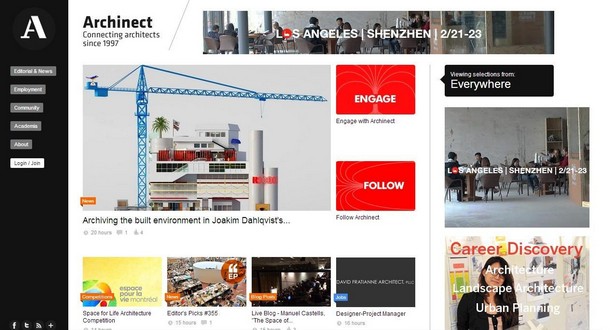- Architecture
- exhibition Review
- Rem Koolhaas Gives Beleaguered City Folk a Trip to the Countryside
- Una casa de vidrio en el desierto
- A Glass House in the Mexican Desert
- Calculator
- How Is the Pandemic Shaping Home Design?
- At the U.S. Olympic and Paralympic Museum, All Athletes Are Equal
- The Little-Known Women Behind Some Well-Known Landscapes
- Walking New York City’s 42nd Street
- Understatement Is the New Luxury
- weekend roundup
- 8 Things to Do This Weekend
- Critic’s notebook
- The East Village, Home of Punks and Poets: Here’s a Tour
- 6 лучших иностранных сайтов об архитектуре
- Статья на английском: Architecture/ Архитектура
Architecture
exhibition Review
Rem Koolhaas Gives Beleaguered City Folk a Trip to the Countryside
In the last eight months, events have proved the celebrated architect’s premise prescient. By focusing on cities, planners have missed propulsive changes in the hinterlands.
Una casa de vidrio en el desierto
En las afueras de San Miguel de Allende, México, un retiro modernista es un reflejo —también literal— de la belleza natural.
By Michaela Trimble
A Glass House in the Mexican Desert
Just outside San Miguel de Allende, this modernist retreat reflects natural beauty in more ways than one.
By Michaela Trimble
Calculator
How Is the Pandemic Shaping Home Design?
A recent survey of architects reveals that clients are looking for ways to improve the time they spend at home.
By Michael Kolomatsky
At the U.S. Olympic and Paralympic Museum, All Athletes Are Equal
The new museum in Colorado Springs is based on the idea that a wheelchair basketball player trains just as hard as any other basketball player.
By Ray Mark Rinaldi
The Little-Known Women Behind Some Well-Known Landscapes
“Women have literally shaped the American landscape and continue to today, but their names and contributions are largely unknown.”
Walking New York City’s 42nd Street
Times architecture critic Michael Kimmelman explores what is, in normal times, the busiest thoroughfare in America.
By Michael Kimmelman
Understatement Is the New Luxury
Exotic finishes and ever-clubbier amenities in new developments have given way to livability and calming design.
weekend roundup
8 Things to Do This Weekend
Our critics and writers have selected noteworthy cultural events to experience virtually or in person in New York City.
Critic’s notebook
The East Village, Home of Punks and Poets: Here’s a Tour
Luc Sante, author of “Low Life,” chats about the neighborhood’s history, including CBGB, Warhol’s Electric Circus and the Tompkins Square Park riots.
6 лучших иностранных сайтов об архитектуре
ARCHiPEOPLE внимательно следит за развитием архитектурной тематики в интернет-пространстве. Сегодня мы сделали подборку самых рейтинговых иностранных сайтов о современной архитектуре.
19.02.2014, 20:47 | Автор: Андрей Кановка
Популярный проект чилийских архитекторов Дэвида Ассаэля и Дэвида Басульто ArchDaily – это удачная попытка объяснить, что современные архитекторы вовсе не строят в одном стиле, и каждый проект имеет пусть иногда неочевидную, но особенность. Максимально используя возможности современной коммуникационной среды, ArchDaily дает представление о том, в каком ключе сейчас развивается архитектура – в градостроительстве, в отношении к окружающей среде, в образовании и так далее. Одновременно, представляемые на сайте проекты подаются исключительно как уникальные решения, передающие персональный стиль авторов.
Главная страница сайта Architonic выглядит как каталог товаров мебельного магазина. Вот – стулья, а вот – столы. Мебель для дома, мебель для офиса… Здесь даже есть школьные парты! Поначалу неочевидно, что надо обратить внимание на раздел «Новости и тренды». Но после того как кризис восприятия будет преодолен, окажется, что сайт на самом деле содержит много информации об инновациях, необычных подходах в архитектуре и градостроительстве. Многие статьи посвящены изменению среды вокруг человека не с помощью отвлеченной урбанистической философии, а с помощью интересных технических решений. И тут только станет ясно, что «каталог товаров», захвативший порядочную территорию на главной странице, — это лишь необходимое дополнение.
В сообществе сайта Archinect больше 200 000 членов. Листая страницы, им посвященные, можно только порадоваться, как много на свете красивых людей, но это не самое главное. Главное – это то, что сайт объединяет их не на основе интереса к условным «топ-10 постройкам недели», а на основе интересов профессиональных. Здесь можно найти информацию о лекциях, фестивалях, конференциях и, самое важное, об образовании и трудоустройстве. Объективность в изложении материала удивительная. Подробно описываются проекты не только именитых архитекторов, но и мало кому известных студентов. Если в изучении процесса становления архитекторов необходимости нет, то можно воспользоваться дочерним сайтом Bustler, на котором аккумулируется только актуальная информация о конкурсах и событиях.
Интересно, что может публиковаться на сайте World Architecture News? Надо же, новости архитектуры! Без иронии, это очень удобный сайт для ознакомления с последними новинками во всем мире. Относительно WAN ( World Architecture News) , определение «во всем мире» — это не просто слова. Здесь есть пять основных разделов, посвященных Северной Америке, Европе, Азии и Тихоокеанскому региону, Среднему Востоку и Африке, Южной Америке. Когда вы в последний раз что-нибудь слышали о проектах, осуществляемых в Кении или в Боливии? Никогда? WAN как раз и дает возможность понять, что же на самом деле представляет собой всемирная архитектура, территориально не ограниченная крупнейшими городами «золотого миллиарда».
Если познавательная функция сайта вам не нужна, можно перейти к разделу «Работа». Вакансий не очень много – в этом сайт проигрывает Bustler’у. Зато на дочернем Wantoday представлено огромное количество тендеров.
Чем может быть интересен итальянский сайт Edilportale? Если вы не итальянец, то ответить на вопрос затруднительно. Однако именно он дал толчок к развитию сообщества Archilovers с внушительным количеством участников в 600 000 человек. Что их сюда привлекло? Возможность самим писать об архитектуре! Это настоящее живое сообщество, где его члены более или менее удачно пишут о том, что их действительно интересует. Но обратить внимание следует в первую очередь все-таки на способ подачи информации о проектах. Информация о них сгруппирована по разделам: «Детали» (например, отдельно можно прочитать про фасады, террасы, озеленение крыш и т.д.), «Материалы» (тут все понятно – кирпичь, стекло и т.п.), «Темы» (исторический контекст, цветовые решения, редевелопмент и прочее, и прочее).
Статья на английском: Architecture/ Архитектура
Здесь вы можете найти статью на английском: Architecture/ Архитектура.
Architecture the art of building in which human requirements and construction materials are related so as to furnish practical use as well as an aesthetic solution, thus differing from the pure utility of engineering construction. As an art, architecture is essentially abstract and nonrepresentational and involves the manipulation of the relationships of spaces, volumes, planes, masses, and voids. Time is also an important factor in architecture, since a building is usually comprehended in a succession of experiences rather than all at once. In most architecture there is no one vantage point from which the whole structure can be understood. The use of light and shadow, as well as surface decoration, can greatly enhance a structure.
The analysis of building types provides an insight into past cultures and eras. Behind each of the greater styles lies not a casual trend nor a vogue, but a period of serious and urgent experimentation directed toward answering the needs of a specific way of life. Climate, methods of labor, available materials, and economy of means all impose their dictates. Each of the greater styles has been aided by the discovery of new construction methods. Once developed, a method survives tenaciously, giving way only when social changes or new building techniques have reduced it. That evolutionary process is exemplified by the history of modern architecture, which developed from the first uses of structural iron and steel in the mid-19th cent.
Until the 20th cent. there were three great developments in architectural construction—the post-and-lintel, or trabeated, system; the arch system, either the cohesive type, employing plastic materials hardening into a homogeneous mass, or the thrust type, in which the loads are received and counterbalanced at definite points; and the modern steel-skeleton system. In the 20th cent. new forms of building have been devised, with the use of reinforced concrete and the development of geodesic and stressed-skin (light material, reinforced) structures.
See also articles under countries, e.g., American architecture; styles, e.g., baroque; periods, e.g., Gothic architecture and art; individual architects, e.g., Andrea Palladio; individual stylistic and structural elements, e.g., tracery, orientation; specific building types, e.g., pagoda, apartment house.
Architecture of the Ancient World
In Egyptian architecture, to which belong some of the earliest extant structures to be called architecture (erected by the Egyptians before 3000 BC), the post-and-lintel system was employed exclusively and produced the earliest stone columnar buildings in history. The architecture of W Asia from the same era employed the same system; however, arched construction was also known and used. The Chaldaeans and Assyrians, dependent upon clay as their chief material, built vaulted roofs of damp mud bricks that adhered to form a solid shell.
After generations of experimentation with buildings of limited variety the Greeks gave to the simple post-and-lintel system the purest, most perfect expression it was to attain. Roman architecture, borrowing and combining the columns of Greece and the arches of Asia, produced a wide variety of monumental buildings throughout the Western world. Their momentous invention of concrete enabled the imperial builders to exploit successfully the vault construction of W Asia and to cover vast unbroken floor spaces with great vaults and domes, as in the rebuilt Pantheon (2d cent. AD;).
The Evolution of Styles in the Christian Era
The Romans and the early Christians also used the wooden truss for roofing the wide spans of their basilica halls. Neither Greek, Chinese, nor Japanese architecture used the vault system of construction. However, in the Asian division of the Roman Empire, vault development continued; Byzantine architects experimented with new principles and developed the pendentive, used brilliantly in the 6th cent. for the Church of Hagia Sophia in Constantinople.
The Romanesque architecture of the early Middle Ages was notable for strong, simple, massive forms and vaults executed in cut stone. In Lombard Romanesque (11th cent.) the Byzantine concentration of vault thrusts was improved by the device of ribs and of piers to support them. The idea of an organic supporting and buttressing skeleton of masonry, here appearing in embryo, became the vitalizing aim of the medieval builders. In 13th-century Gothic architecture it emerged in perfected form, as in the Amiens and Chartres cathedrals.
The birth of Renaissance architecture (15th cent.) inaugurated a period of several hundred years in Western architecture during which the multiple and complex buildings of the modern world began to emerge, while at the same time no new and compelling structural conceptions appeared. The forms and ornaments of Roman antiquity were resuscitated again and again and were ordered into numberless new combinations, and structure served chiefly as a convenient tool for attaining these effects. The complex, highly decorated baroque style was the chief manifestation of the 17th-century architectural aesthetic. The Georgian style was among architecture’s notable 18th-century expressions. The first half of the 19th cent. was given over to the classic revival and the Gothic revival.
New World, New Architectures
The architects of the later 19th cent. found themselves in a world being reshaped by science, industry, and speed. A new eclecticism arose, such as the architecture based on the Ecole des Beaux-Arts , and what is commonly called Victorian architecture in Britain and the United States. The needs of a new society pressed them, while steel, reinforced concrete, and electricity were among the many new technical means at their disposal.
After more than a half-century of assimilation and experimentation, modern architecture, often called the International style, produced an astonishing variety of daring and original buildings, often steel substructures sheathed in glass. The Bauhaus was a strong influence on modern architecture. As the line between architecture and engineering became a shadow, 20th-century architecture often approached engineering, and modern works of engineering—airplane hangars, for example—often aimed at and achieved an undeniable beauty. More recently, postmodern architecture, which exploits and expands the technical innovations of modernism while often incorporating stylistic elements from other architectural styles or periods, has become an international movement.

















